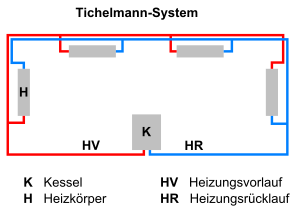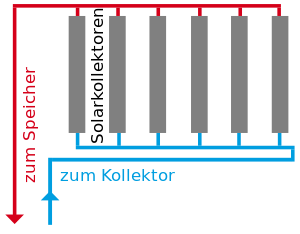Tichelmann system
The Tichelmann system is a special form of pipe laying in heating construction.
principle
With the Tichelmann system ( Tichelmann pipe routing ), the pipes are routed from the heat generator (e.g. boiler , solar system ) to the heat consumer (e.g. radiator , hot water storage tank ) and back in a ring layout so that the sum of the lengths of the flow line and return line at is roughly the same for every radiator. Radiators with a short flow have a long return line and vice versa. The point here is that all radiators are exposed to roughly the same pressure losses and thus the same volume flows = the same heat flows in the radiators, even if no control valves are used. This causes even heating of radiators that are further away. A connection according to "Tichelmann" also means that the total pressure loss coefficients (zeta values) of the pipe fittings for connecting several identical components (hot water storage tank or solar collectors as a rule) are the same for each individual unit, so that an even flow is guaranteed. The pressure losses in the supply lines, which should be the same for all components, are therefore made up of pipe friction, i.e. H. the internal roughness, the diameter and the length and the pressure loss coefficient of the fittings. The pressure loss coefficients (zeta values) are determined empirically and made available in tabular form in the literature.
Even solar panels are often connected to this system, so that all are equally strong flows.
By installing regulating valves in the supply line to the radiator, hydraulic balancing can be carried out more easily and even with different pipe lengths. This is why this piping is rarely used in heating construction.
advantages
In contrast to the adjustment by valves, in the Tichelmann system no pump output is consumed by unnecessary resistances. It is the only system in which a hydraulically balanced system can be created with the least possible resistance.
disadvantage
This advantage is offset by a number of disadvantages: slightly higher material consumption, since the pipes are not routed along the shortest possible route, complex thermal insulation is required for pipe reductions because the diameters are unequal , and the supply and return pipes running next to each other have different slopes. Thus, pipe laying according to Tichelmann is expensive in terms of material consumption and pipe assembly, so that it is rarely used in private households, but rather in large installations such as B. is installed in apartment buildings. However, the total costs are mostly offset by the omission of control valves in new systems. When renovating old buildings, the additional effort is usually so high that a comparison using regulating valves is used.
Origin of name
The installation system is named after Albert Tichelmann (1861–1926), who was an engineer in the field of hot water heating. He put Hermann Rietschel's theses into practice, first as his assistant, then in industry and finally in his own company Jeglinsky & Tichelmann ( Dresden ), which he founded with a partner around 1903. In his honor, the Association of German Engineers (VDI) awards the Albert Tichelmann Prize every year for outstanding work in the field of technical building equipment.
Web links
literature
- Klaus W. Usemann: Development of heating and ventilation technology into science: Hermann Rietschel - life and work. Oldenbourg, Munich 1993, ISBN 3-486-26138-X .

